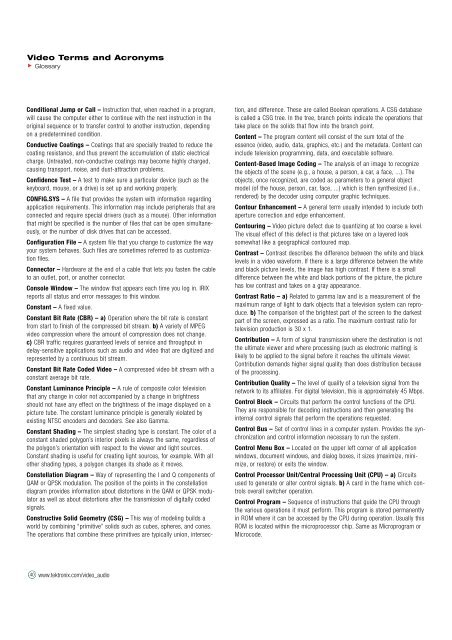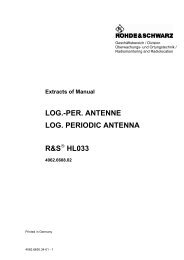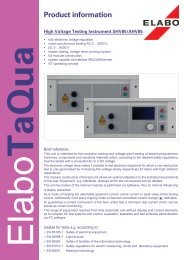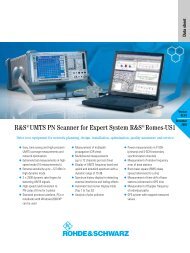Glossary of Video Terms and Acronyms - Isotest
Glossary of Video Terms and Acronyms - Isotest
Glossary of Video Terms and Acronyms - Isotest
You also want an ePaper? Increase the reach of your titles
YUMPU automatically turns print PDFs into web optimized ePapers that Google loves.
<strong>Video</strong> <strong>Terms</strong> <strong>and</strong> <strong>Acronyms</strong><br />
<strong>Glossary</strong><br />
Conditional Jump or Call – Instruction that, when reached in a program,<br />
will cause the computer either to continue with the next instruction in the<br />
original sequence or to transfer control to another instruction, depending<br />
on a predetermined condition.<br />
Conductive Coatings – Coatings that are specially treated to reduce the<br />
coating resistance, <strong>and</strong> thus prevent the accumulation <strong>of</strong> static electrical<br />
charge. Untreated, non-conductive coatings may become highly charged,<br />
causing transport, noise, <strong>and</strong> dust-attraction problems.<br />
Confidence Test – A test to make sure a particular device (such as the<br />
keyboard, mouse, or a drive) is set up <strong>and</strong> working properly.<br />
CONFIG.SYS – A file that provides the system with information regarding<br />
application requirements. This information may include peripherals that are<br />
connected <strong>and</strong> require special drivers (such as a mouse). Other information<br />
that might be specified is the number <strong>of</strong> files that can be open simultaneously,<br />
or the number <strong>of</strong> disk drives that can be accessed.<br />
Configuration File – A system file that you change to customize the way<br />
your system behaves. Such files are sometimes referred to as customization<br />
files.<br />
Connector – Hardware at the end <strong>of</strong> a cable that lets you fasten the cable<br />
to an outlet, port, or another connector.<br />
Console Window – The window that appears each time you log in. IRIX<br />
reports all status <strong>and</strong> error messages to this window.<br />
Constant – A fixed value.<br />
Constant Bit Rate (CBR) – a) Operation where the bit rate is constant<br />
from start to finish <strong>of</strong> the compressed bit stream. b) A variety <strong>of</strong> MPEG<br />
video compression where the amount <strong>of</strong> compression does not change.<br />
c) CBR traffic requires guaranteed levels <strong>of</strong> service <strong>and</strong> throughput in<br />
delay-sensitive applications such as audio <strong>and</strong> video that are digitized <strong>and</strong><br />
represented by a continuous bit stream.<br />
Constant Bit Rate Coded <strong>Video</strong> – A compressed video bit stream with a<br />
constant average bit rate.<br />
Constant Luminance Principle – A rule <strong>of</strong> composite color television<br />
that any change in color not accompanied by a change in brightness<br />
should not have any effect on the brightness <strong>of</strong> the image displayed on a<br />
picture tube. The constant luminance principle is generally violated by<br />
existing NTSC encoders <strong>and</strong> decoders. See also Gamma.<br />
Constant Shading – The simplest shading type is constant. The color <strong>of</strong> a<br />
constant shaded polygon’s interior pixels is always the same, regardless <strong>of</strong><br />
the polygon’s orientation with respect to the viewer <strong>and</strong> light sources.<br />
Constant shading is useful for creating light sources, for example. With all<br />
other shading types, a polygon changes its shade as it moves.<br />
Constellation Diagram – Way <strong>of</strong> representing the I <strong>and</strong> Q components <strong>of</strong><br />
QAM or QPSK modulation. The position <strong>of</strong> the points in the constellation<br />
diagram provides information about distortions in the QAM or QPSK modulator<br />
as well as about distortions after the transmission <strong>of</strong> digitally coded<br />
signals.<br />
Constructive Solid Geometry (CSG) – This way <strong>of</strong> modeling builds a<br />
world by combining “primitive” solids such as cubes, spheres, <strong>and</strong> cones.<br />
The operations that combine these primitives are typically union, intersec-<br />
40 www.tektronix.com/video_audio<br />
tion, <strong>and</strong> difference. These are called Boolean operations. A CSG database<br />
is called a CSG tree. In the tree, branch points indicate the operations that<br />
take place on the solids that flow into the branch point.<br />
Content – The program content will consist <strong>of</strong> the sum total <strong>of</strong> the<br />
essence (video, audio, data, graphics, etc.) <strong>and</strong> the metadata. Content can<br />
include television programming, data, <strong>and</strong> executable s<strong>of</strong>tware.<br />
Content-Based Image Coding – The analysis <strong>of</strong> an image to recognize<br />
the objects <strong>of</strong> the scene (e.g., a house, a person, a car, a face, ...). The<br />
objects, once recognized, are coded as parameters to a general object<br />
model (<strong>of</strong> the house, person, car, face, ...) which is then synthesized (i.e.,<br />
rendered) by the decoder using computer graphic techniques.<br />
Contour Enhancement – A general term usually intended to include both<br />
aperture correction <strong>and</strong> edge enhancement.<br />
Contouring – <strong>Video</strong> picture defect due to quantizing at too coarse a level.<br />
The visual effect <strong>of</strong> this defect is that pictures take on a layered look<br />
somewhat like a geographical contoured map.<br />
Contrast – Contrast describes the difference between the white <strong>and</strong> black<br />
levels in a video waveform. If there is a large difference between the white<br />
<strong>and</strong> black picture levels, the image has high contrast. If there is a small<br />
difference between the white <strong>and</strong> black portions <strong>of</strong> the picture, the picture<br />
has low contrast <strong>and</strong> takes on a gray appearance.<br />
Contrast Ratio – a) Related to gamma law <strong>and</strong> is a measurement <strong>of</strong> the<br />
maximum range <strong>of</strong> light to dark objects that a television system can reproduce.<br />
b) The comparison <strong>of</strong> the brightest part <strong>of</strong> the screen to the darkest<br />
part <strong>of</strong> the screen, expressed as a ratio. The maximum contrast ratio for<br />
television production is 30 x 1.<br />
Contribution – A form <strong>of</strong> signal transmission where the destination is not<br />
the ultimate viewer <strong>and</strong> where processing (such as electronic matting) is<br />
likely to be applied to the signal before it reaches the ultimate viewer.<br />
Contribution dem<strong>and</strong>s higher signal quality than does distribution because<br />
<strong>of</strong> the processing.<br />
Contribution Quality – The level <strong>of</strong> quality <strong>of</strong> a television signal from the<br />
network to its affiliates. For digital television, this is approximately 45 Mbps.<br />
Control Block – Circuits that perform the control functions <strong>of</strong> the CPU.<br />
They are responsible for decoding instructions <strong>and</strong> then generating the<br />
internal control signals that perform the operations requested.<br />
Control Bus – Set <strong>of</strong> control lines in a computer system. Provides the synchronization<br />
<strong>and</strong> control information necessary to run the system.<br />
Control Menu Box – Located on the upper left corner <strong>of</strong> all application<br />
windows, document windows, <strong>and</strong> dialog boxes, it sizes (maximize, minimize,<br />
or restore) or exits the window.<br />
Control Processor Unit/Central Processing Unit (CPU) – a) Circuits<br />
used to generate or alter control signals. b) A card in the frame which controls<br />
overall switcher operation.<br />
Control Program – Sequence <strong>of</strong> instructions that guide the CPU through<br />
the various operations it must perform. This program is stored permanently<br />
in ROM where it can be accessed by the CPU during operation. Usually this<br />
ROM is located within the microprocessor chip. Same as Microprogram or<br />
Microcode.





